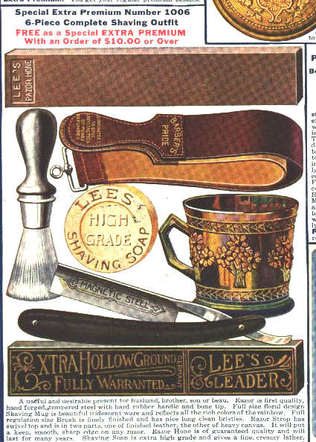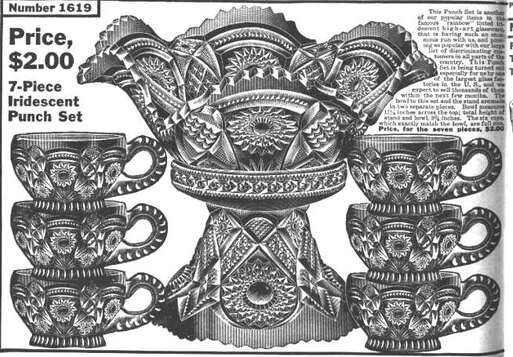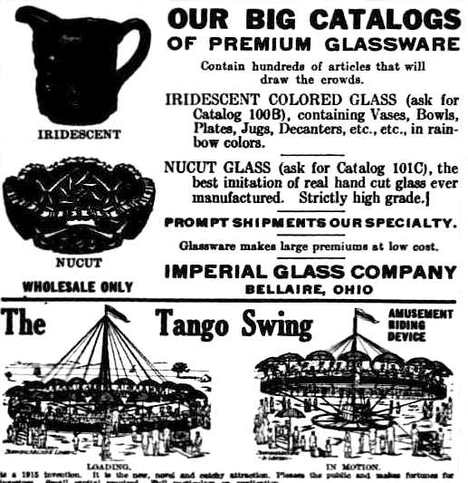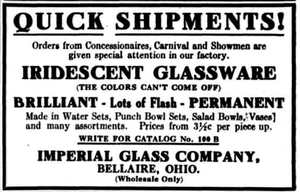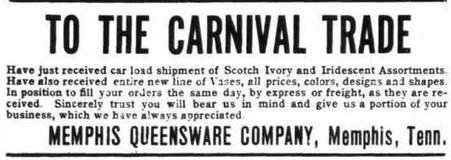Carnival Glass - what's in a name?
Although Carnival Glass is now the generally accepted name for this astonishingly beautiful, highly sought-after and internationally collected form of art glass, it has not always been so. When it was originally advertised for sale in the early 1900s it was variously called "Pompeiian Iridescent", "Venetian Art", and "Mexican Aurora", all terms that were intended to help it sell.
How did the name Carnival Glass come about, and why did this name stick?
The accepted wisdom is that, possibly due to overstocking or maybe an excess of poorer quality items swamping the market in the 1920s and 1930s, some of the iridised glass made in the USA began to be given away at carnivals and county fairs, and subsequently the name "Carnival Glass" simply stuck. Although on the face of it, it feels like a derogatory term, a bit of a “put down,” it actually works!
However, the story is more complicated ..... and more interesting than that! Let's take a look at how Carnival Glass (as we now call it) was presented in the press at the time.
Lee Manufacturing Catalog, Chicago (c 1915)
Lee Manufacturing was a US mail order company. Below are two of their advertisements that showed Carnival Glass.
|
This advert was in a special loose-leaf colour supplement to Lee's main catalogue. The blue Fenton Orange Tree shaving mug is delightfully presented amongst a group called a “6-piece Complete Shaving Outfit”. The text at the bottom that refers to the Carnival mug is a little hard to read. It says:
"Full size floral design Shaving Mug is beautiful iridescent ware and reflects all the rich colours of the rainbow." |
This is a wonderful Lee ad for a Fashion punch set, made by Imperial.
The text reads: "This punch set is another of our popular items in the famous "rainbow" tinted iridescent high-art glassware, that is having such an enormous run with us, and proving so popular with our large list of discriminating customers in all parts of the country. This punch set is being turned out especially for us by one of the largest glass factories in the U.S. and we expect to sell thousands of them within the next few months. The bowl to this set and the stand are made in two separate pieces. Bowl measures 11 3/4" across the top; total height of stand and bowl, 9 3/4". The six cups which exactly match the bowl, are full size. The price for the seven pieces, $2.00 (sic!). |
The Billboard (from 1915 and later)
As we said earlier, it was considered that the name Carnival Glass came about in the 1920s and 1930s when some of the iridised glass made in the USA began to be given away as prizes at carnivals and county fairs.
However, from as early as 1915, ads for glass as carnival prizes appeared in a popular journal called The Billboard. It was originally intended to be the trade paper for the bill posting industry, The Billboard quickly widened its scope and was soon carrying ads, news and information for circuses, carnivals, amusement parks, fairs and more.
|
The ad on the left is from 1915, and the text - "hundreds of articles that will draw the crowds" - links with the imagery of fairground rides, carnivals and an "Amusement riding device"! The ads below is are from 1915 and 1917 and are more explicit, specifically offering Iridescent Glassware to "Concessionaires, Carnival and Showmen", and Iridescent Assortments for the Carnival Trade.
|
So what we see in The Billboard ads was an emerging picture of iridescent glass being firmly associated with carnivals from as early as 1915, being reinforced time after time. By the 1920s the association was well established: there is ad for the San Francisco store, Kindel & Graham, which had a list of items including iridescent glass under the headline “Announcing our 1922 Carnival Novelties”. It’s clear to see how the term Carnival Glass slowly but surely began to enter the vernacular.
|
Slum Glass? The term in common usage in the 1920s for items that were used as free prizes for Carnival games and the like, was “slum” or “slum give-away”. The two extracts on the right show the popular use of, and the context for, these terms. In fact we should probably be glad that the name “Carnival” stuck. It could have been called “Slum Glass” instead! |
"Carnival Glass" came to be the generally accepted name, and Carnival sums up the excitement, the dynamism, and the thrilling sparkle of Carnival Glass collecting. However we do need to recognise one of the early Carnival pioneers who put the name "Carnival Glass" into popular use in the early 1950s; that person was Gertrude Conboy who in January 1952 wrote an immensely significant article in a popular magazine called the "Spinning Wheel including Antiques Digest". The article was “The Glass of Many Names Now Known as Carnival” and you can read all about it here: Conboy and Plummer - Carnival Pioneers.
Subsequently names like "Nancy glass", "Baking Powder glass" and "Poor Man's Tiffany" were used by collectors, and in parts of Scandinavia it was (and sometimes still is) referred to as “poison glass” – a black humour reference to the toxic nature of the chemicals used in its manufacture.
Here is an astonishing list of over 100 names that Carnival has been known by, since its introduction in 1907.
Subsequently names like "Nancy glass", "Baking Powder glass" and "Poor Man's Tiffany" were used by collectors, and in parts of Scandinavia it was (and sometimes still is) referred to as “poison glass” – a black humour reference to the toxic nature of the chemicals used in its manufacture.
Here is an astonishing list of over 100 names that Carnival has been known by, since its introduction in 1907.
|
Acid glass
African Amerikaner glass Aurora Aurora Golden Iridescent Aurora Iris Baking Powder Glass Bohemian iridescent Byzantine iridescent Canadian glass Carnaval glass Carnave glass Carneval Carnivar glass Carnical glass Carniville glass Carnival glass Carny glass Centennial glass Circus Glass Dope glass Dopple glass Egyptian Art Etruscan Exhibition glass Exposition Metallic Fairground glass Fireglow Florentine iridescent Gas House glass Giveaway / Give-away Glass Golden Beauty Golden Glow Golden Sunset Golden Iris |
Goldiris
Gypsy glass Imitation Tiffany Indiana glass Iridescent Iridie Iridil Iridill Lovely coloured glass Listerlasi Lüster Lüsterdekor Lustraglas Lustre glass Lysterglas Magnet glassware Marigold Marvel iridescent Metallic iridescent Metallized Egyptian Art Glass Mexican Aurora Monarch glassware Moonglow Myrkilasi Nancy glass Naples glass National glass New Aurora New Etruscan New Venetian Art Norcross Northwood iridescent Oil glass Oil Lustre Old Jersey |
Opalescent
Oriental iridescent Orient iridescent Oyster sheen glass Panther Parisian Art Peacock color glass Peacock Lustre glass Pearl iridescent Persian Pearl Petro-glass Pompeiian Iridescent Poison Glass Poor Man's Tiffany Radiant Luster Radium Rainbo Lustre Regal iridescent Royal iridescent Royal novelty Rubigold glassware Russian glass Sandwich Slum Glass Spanish American glass Stuff they used to give away Sunglow Sunset Glass Taffeta Glass Woolworth glass Venetian Art Venetian iridescent Victorian Art Glass Working Man's Tiffany |
